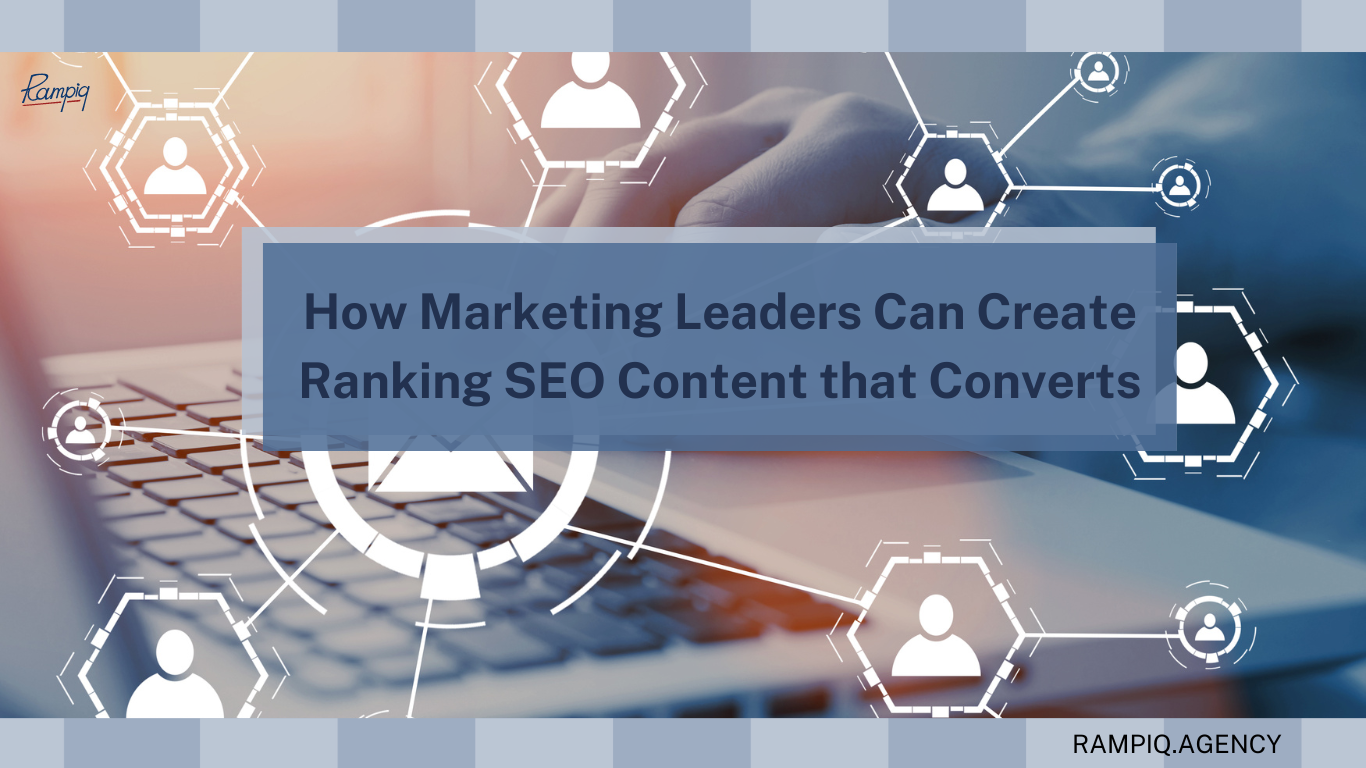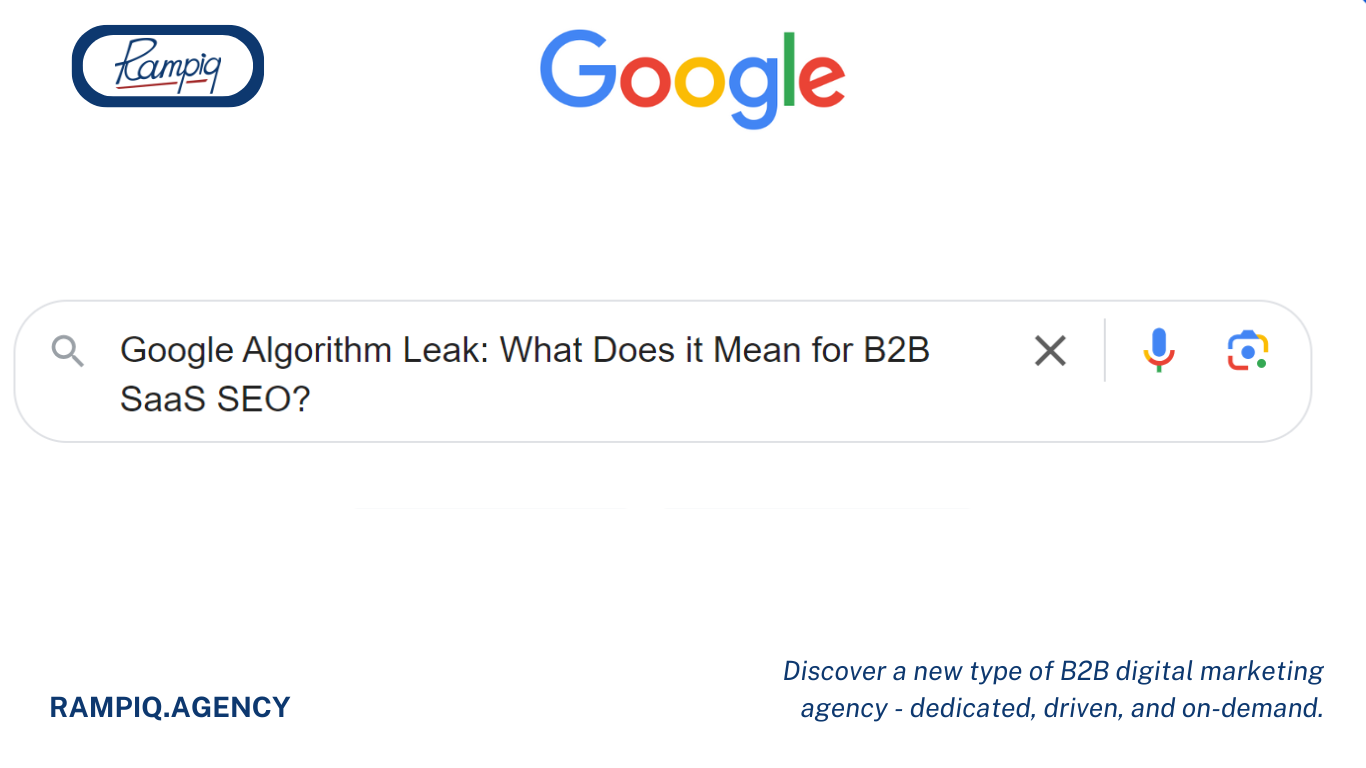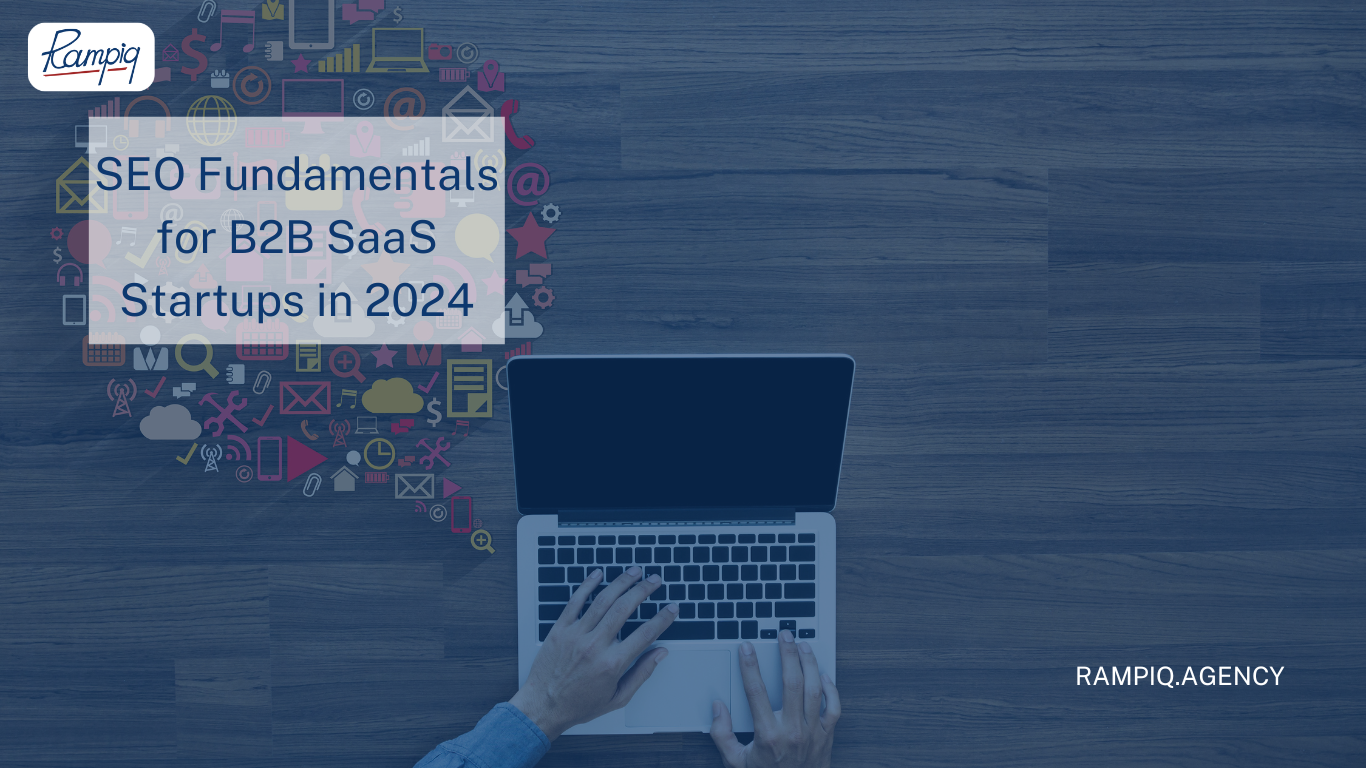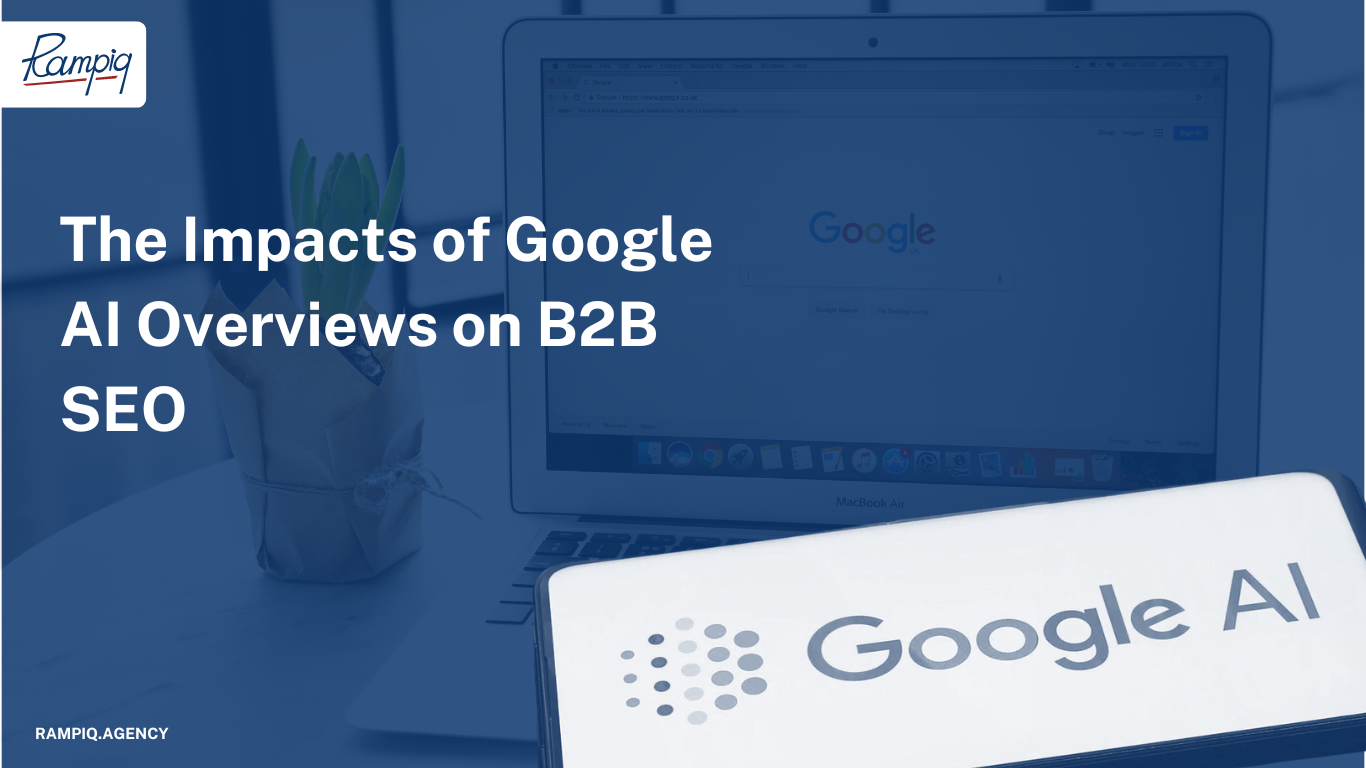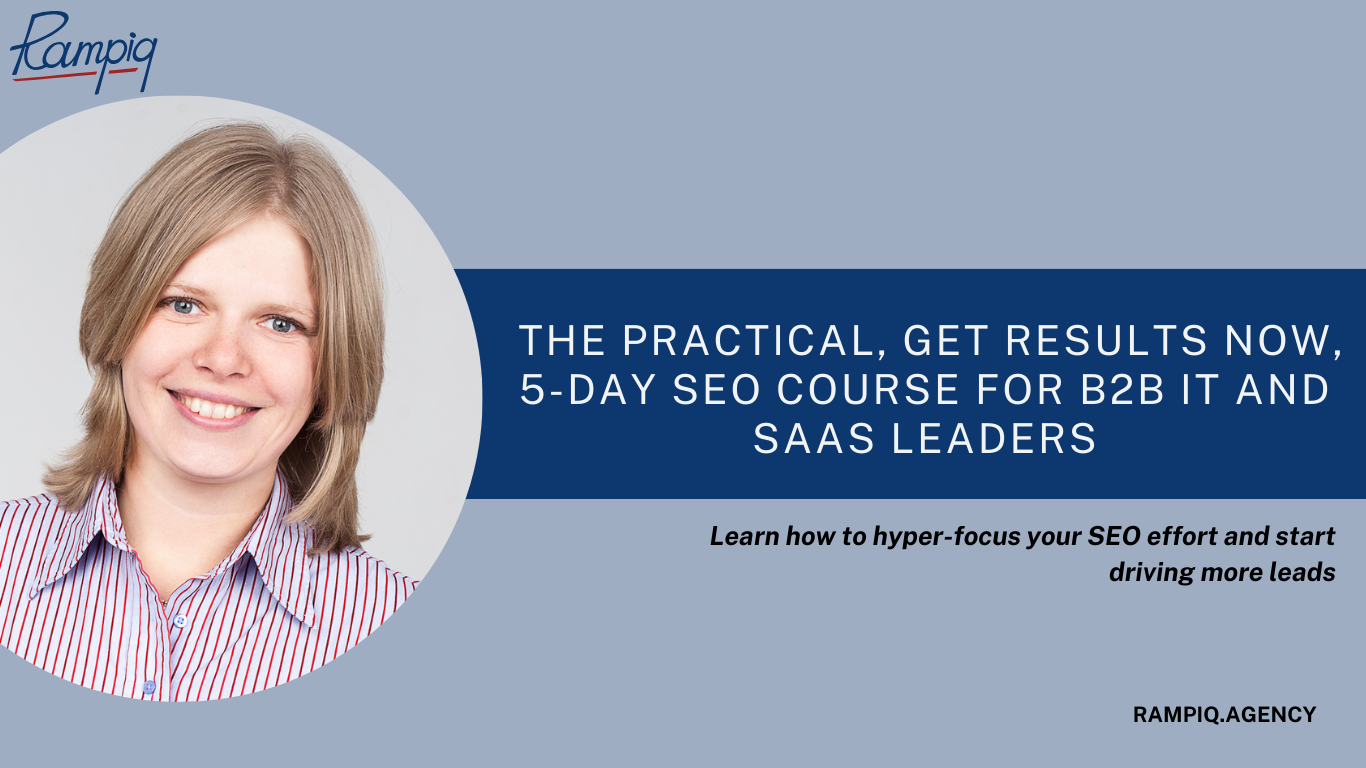What is (and isn’t) AI?
AI is Artificial Intelligence, and it refers to any technology that mimics human intelligence to perform tasks. There are so many misconceptions about the impact AI’s growth will have, especially in the SEO world.
When AI tools like Chat GPT and Jasper were released, it took the content marketing world to a standstill, and every guru had a say on how they’d disrupt the content marketing world. This is a surprise because we’ve been using AI-powered tools in SEO for years. For instance, Ahrefs or Semrush have been helping us with SEO tasks such as keyword research, site auditing, and link building all through. You can use AI for SEO in many creative ways besides generating text. Read on to see how to incorporate AI into your SEO strategy to make a difference.
The Role of AI in SEO
AI has changed and improved how SEO in the SaaS industry is done. It makes it easier to understand the searcher’s intent and accurately predict what they might need in the future.
Marketers can now generate keywords, analyze their competitor’s data, track user behavior, optimize content, and develop better strategies.
All this was possible using traditional SEO methods, it’s just easier and more effective with AI tools. For example, without AI tools, you’d have to manually analyze every site ranking for a certain keyword to know how to outrank them. Now with AI tools like Thruu, you can get all the data you need by simply entering a keyword. This includes how many words every ranking article has, how many images they have, keywords they’re ranking for, and even a brief of what to cover to outrank them; you don’t need to read every single article anymore.
This is not the only SEO process you can automate; we will discuss other ways SaaS companies can use AI for SEO and what tools to use later in the article.
The Ever-Changing Landscape of SEO
The Google algorithm has improved over the years, and with every search algorithm update, the rules change. Google is built to serve users and provide them with meaningful answers.
The Evolution of SEO Over the Years
Here are ways through which has changed the course of SEO over the years:
2003-2005
This is the first time Google started regulating websites based on the quality of content they were producing. Google started penalizing sites using unethical ranking methods, such asPBNs to build backlinks.
This update personalized searches and is based on the user’s suggestion in their search history. It also led to the introduction of local SEO to help searchers access valuable information about the sellers, shops, and services close to them.
2006-2009
Google continued using searchers’ behavior to improve their search engines, which led to the development of NLP ( more on this later).
They also started including images and videos as answers to queries. Google also included Twitter, Google News updates, and new-indexed content to produce user-focused content.
As a result, marketers started to optimize their websites with the user intent in mind to gain more exposure.
2010-2012
Google became more strict with its regulations on keyword research, content quality, and optimization. They did a major algorithm update, leading to some major sites losing their top positions and traffic.
This was the year Google+ was introduced to grow social media influence. Marketers began sharing their content on other social media platforms for more engagement, building authority, and boosting visibility.
2013-2023
SEO focuses more on building relevant content and ensuring it’s accessible across all devices. Websites with non-responsive designs and poor mobile optimization are poorly ranked.
To rank better, marketers have to produce creative and informative content and build real relationships with their audience.
The Future: What to Expect
Google will continue improving the user’s experience by making it easier to get the answers they’re looking for without looking too far. This is to fulfill the searchers’ instant gratification because they want immediate responses.
Search engines will also continue to personalize searches from other platforms too to meet the searcher’s intent. Marketers will have to build their companies’ presence across all platforms to stay relevant; this means producing blogs and visual content too. Luckily, with the emergence of AI tools, this is manageable.
The only thing to keep in mind as you prepare for the future is that shortcuts are very costly; in the past 25 years, Google has been rewarding genuine websites and penalizing sites that try to outsmart them to rank.
The Role of Natural Language Processing (NLP) and Machine Learning in SEO
NLP is a subfield of artificial intelligence that helps machines process and understand human language to automate repetitive tasks.
How does NLP help in SEO, and why isn’t it important in SEO? There has yet to be new studies, but in 2017, Google realized that 15% of their daily queries were new: This means that sometimes Google doesn’t have any historical data when searchers enter long tail keywords.
Seeing as the searchers keep the lights on at Google, they introduced NLP to help their machine better understand queries.
Luckily, we have tools like Surfer SEO that help you check the level at which your article is NLP optimized and improve it.
Creative Ways SaaS Companies Can Use AI for SEO
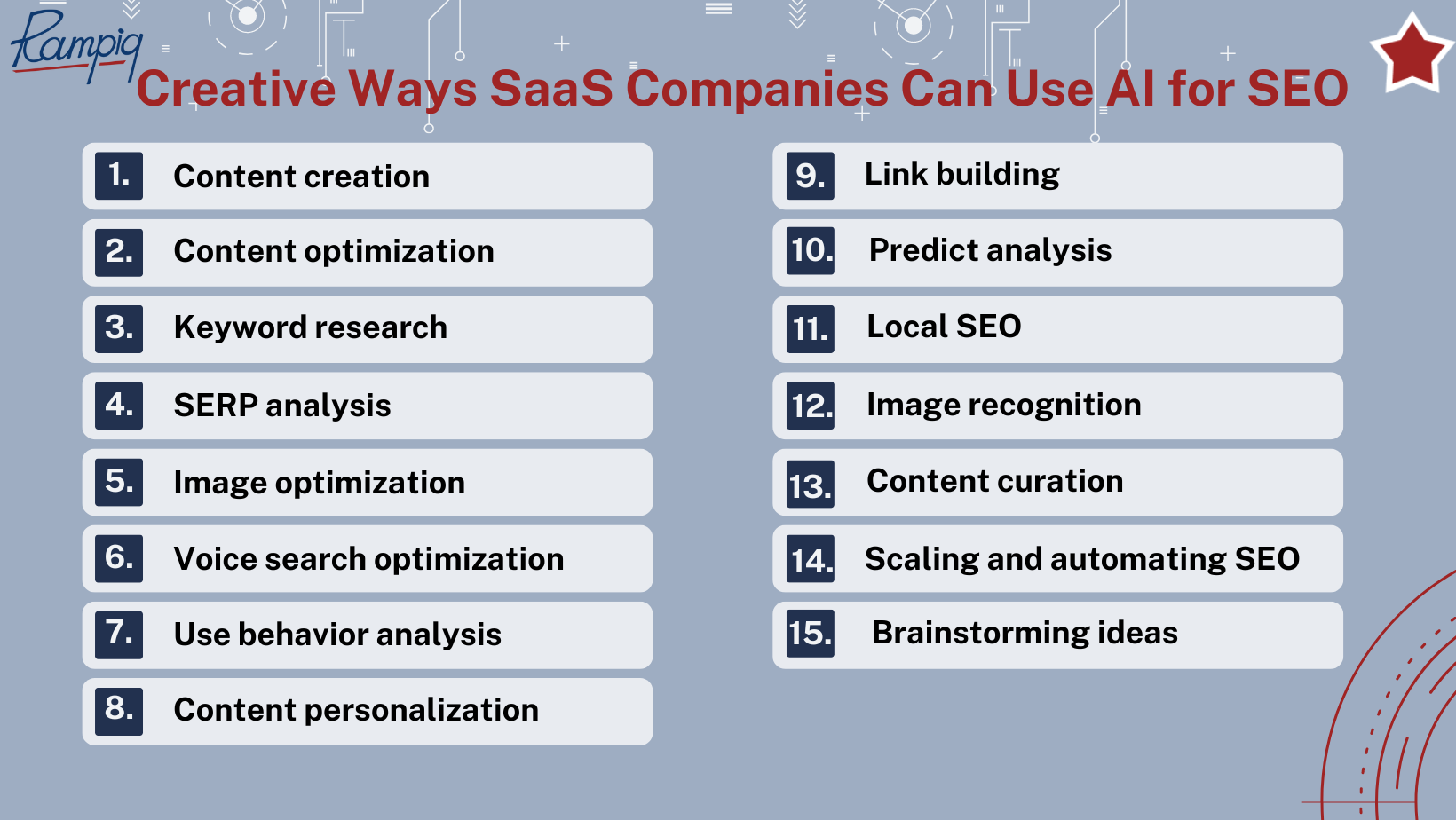
Now, onto the fun part, how can Saas companies use AI for SEO? Here are 16 exciting ways:
1. Content Creation
Content creation is the process of coming up with ideas that appeal to your potential buyers; it can be in the form of images, articles or videos.
You can use AI to find what topics your buyer persona is looking for, brainstorm more creative headlines, develop outlines, and write better meta descriptions.
For example, if you’re struggling with writer’s block, Chat GPT or Jasper can help you get started by providing you with a first draft. Remember, AI is only supposed to help you, and directly publishing the article can result in Google penalties. If you outsource your blog posts, use AI detectors to confirm your article’s originality.
2. Content Optimization
Content optimization is the process of tweaking your content for search engines to understand it and know who you’re targeting.
To optimize your content, you must build internal links, naturally add keywords throughout the title, and write good meta descriptions and tags. For example, if you suspect you’ve overused certain keywords, you can use a keyword analyzer tool to see what keywords appear more and which ones you need to add. AI tools like Surfer SEO will even help you optimize your content for NLP by showing you the keywords you can add to your article.
Tools you can use for content optimization include Surfer SEO, Frase, Dashword, Clearscope, etc. They show you how your keywords are distributed, whether you need to add extra headers, the number of images you need to improve readability, etc.
3. Keyword Research
Keyword research is researching and analyzing the terms your audience enters into the search engine. It helps you know the exact terms your reader uses to find content.
With AI-powered tools like Ahrefs, you don’t need to manually research or guess what your readers are looking for. You can get access to thousands of keywords that your readers are already looking for or questions they’re asking using AI tools. Ahref even allows you to see what sites rank for certain keywords, how hard it is to outrank them, and other keywords you can use to rank faster.
Some AI-powered tools for keyword research include Ahrefs, Semrush, and Uber Suggest. You can also find free tools such as the keyword planner.
4. SERP Analysis
Search Engine Results Page (SERP) is the process of analyzing the website ranking on the first page to see what you can do better to outrank them.
It also helps you understand the searcher’s intent by seeing what kind of content is ranking. For example, if the first search is a video, it indicates that searchers need video content for that particular keyword.
For example, Semrush provides a chart showing the keyword difficulty, global volume, searcher’s intent, and CPC.
Other AI-powered tools you can use to analyze SERPs, include Mozpro, Ahrefs, and Ubersuggest.
5. Image Optimization
Image optimization is formatting images to load better, like resizing. It’s important because large images can slow down your web pages and reduce the user’s experience.
For example, Imagify can help you compress and resize images, add a trademark symbol and show whether your images are high quality. Other tools you can use to optimize images include Cloudinary, funky resize, and Kraken.io.
6. Voice Search Optimization
Voice search optimization is optimizing your website pages to rank better when your users conduct verbal searches. AI tools can help you analyze your audience’s speeches and how they phrase their questions.
For example, answer the public provides you with long tail keywords when you enter a keyword. If you search content marketing, you can get suggestions such as “why content marketing is important for B2B “Why content marketing works.” Long tail keywords represent how searchers talk in real life and the words they use to search for answers.
Some AI tools you can use include Keyworddit, Wordstream, Long, and Tail Pro.
7. User Behavior Analysis
Behavior analysis is the process of collecting and analyzing user data. It helps you understand how your web visitors interact with your website, what pages they visit, how much time they spend on them, what pages they spend on more extended periods, etc.
Behavior analytics is also a great metric for measuring the success of your SEO strategy.
AI tools can make this process easier by breaking down your website’s performance and how buyers engage with them. For example, Google Analytics helps you see how long users spend on certain pages on your website, the bounce rate, and the traffic you’re getting.
AI tools for behavior analysis include AIOSEO, Mouseflow, Datadog, Crazy Egg, and User Analytics. All these tools help you measure different aspects of behavior analysis.
8. Content Personalization
Content personalization is customizing your content’s brand to align with your customer’s needs and preferences. For example, if you’re a pet e-commerce shop, and your customer checks out puppy food, you can personalize their emails with puppy content. This could be blog posts on how to shop for puppy food or other things a puppy needs.
A good example is Hubspot Customer Service Software which allows you to create pop-up forms to collect your web visitors’ information based on their actions on your website. AI tools you can use for this include Optin Monster, Proof, Segment, and Moosend.
9. Link Building
Link building is a way of building one-way links to your website to boost visibility and ranking. You get a backlink when someone else adds your content to their web content or blog post. It’s a great way to show Google that you’re putting out informative content that experts in your field trust too.
You can try AI tools to find opportunities to get new links, eliminate broken links and analyze your competitor’s links.
For example, Ahrefs, Moz, Semrush, and similar AI-powered tools show you the number of backlinks your competitors have for certain keywords. It also goes ahead and shows you the referring domains; you can analyze the linked articles and reach out to sites linking to broken links and suggest your article as a replacement.
AI link-building tools include Linkody, Semrush, Ahrefs, Majestic, Buzzstream, etc.
10. Predictive Analysis
Predictive analysis in SEO is brainstorming about what your customers may need in the future. This means analyzing your customer’s past and present trends to know what they’ll need in the future.
Predictive analysis helps you serve your customers’ needs before they ask for it. For example, Google Trends shows you how keywords have been performing over different seasons of the year by showing you the traffic it’s been getting. You can see how a keyword performed in the past 24 hours or the last ten years. Using the trends, you can predict how a keyword might perform in the future.
AI tools you can use for predictive analysis include Google Analytics, MarketingCloudFX, Infer, ZoomInfo, Radio Intelligence, etc.
11. Local SEO
Local SEO customizes your online business presence for customers near your area, even without a website. Picture this: you’re near town and craving pizza, so you search “Pizza near me,” and you get suggestions. This is how Local SEO boosts the visibility and sales of your business.
AI tools that can help with Local SEO include Moz Local, BrightLocal, Jasper, Semrush, Ahrefs, etc.
12. Image Recognition
Image recognition technology detects and identifies objects, scenes, or people in video and images. In SEO, we have practices such as adding alt tags to images and image optimization that we perform to boost our visibility.
An optimized image can boost your ranking by increasing accuracy when searching for images related to particular keywords. It also helps describe the context of an image if it’s taking longer to load or on emails where providers don’t automatically expose images.
For example, you can use funky resize to identify the size of your website’s images and format them to ensure they don’t affect the loading speed of your webpage, which could affect how you rank.
AI tools you can use for image recognition include Syte, SupperAnnotate, Dataloop, Google Cloud Vision API, sci-kit-image, etc.
13. Content Curation
Content curation is gathering existing content (from your blog and other sites) into one topic for your audience. This is an incredible hack to give old content a life and increase web visitors to your blog while adding value to your audience.
For example, if you’re a financial advisor, you can use AI-powered applications to compile all tax guides on your site and share them with your email list as a single blog post at the beginning of the tax season.
You can also share other people’s content with your readers; tools like Buzzsumo help you see the contents that your audience is engaging with. If you enter a keyword on Buzzsumo, it shows you what content
AI tools that can assist you with content curation including Pocket, Curata, Pocket, Triberr, Feedzy, etc.
14. Scaling and Automating SEO
Scaling and automating SEO go hand in hand. Scaling SEO means developing a strategy that enables you to expand your SEO efforts. Depending on your priorities, this could mean different things, including increasing your publishing content.
One effective way to go about this is finding activities you can automate. For example, instead of monitoring your traffic manually, you can integrate a tool into your website to alert you in case of any significant traffic dips.
15. Brainstorming Ideas
Sometimes we need some help to get started; this could be generating new content ideas or knowing what to write for a blog post.
You can use AI tools to generate content outlines, headlines, meta descriptions, or even create a blog post to jumpstart you. For example, Chat GPT can help write a first draft for you, which you can use as a guide.
Here are some tools for brainstorming Thruu, Chat GPT, Ahrefs, Jasper, Frase, and Surfer SEO.
Best AI SEO Tools
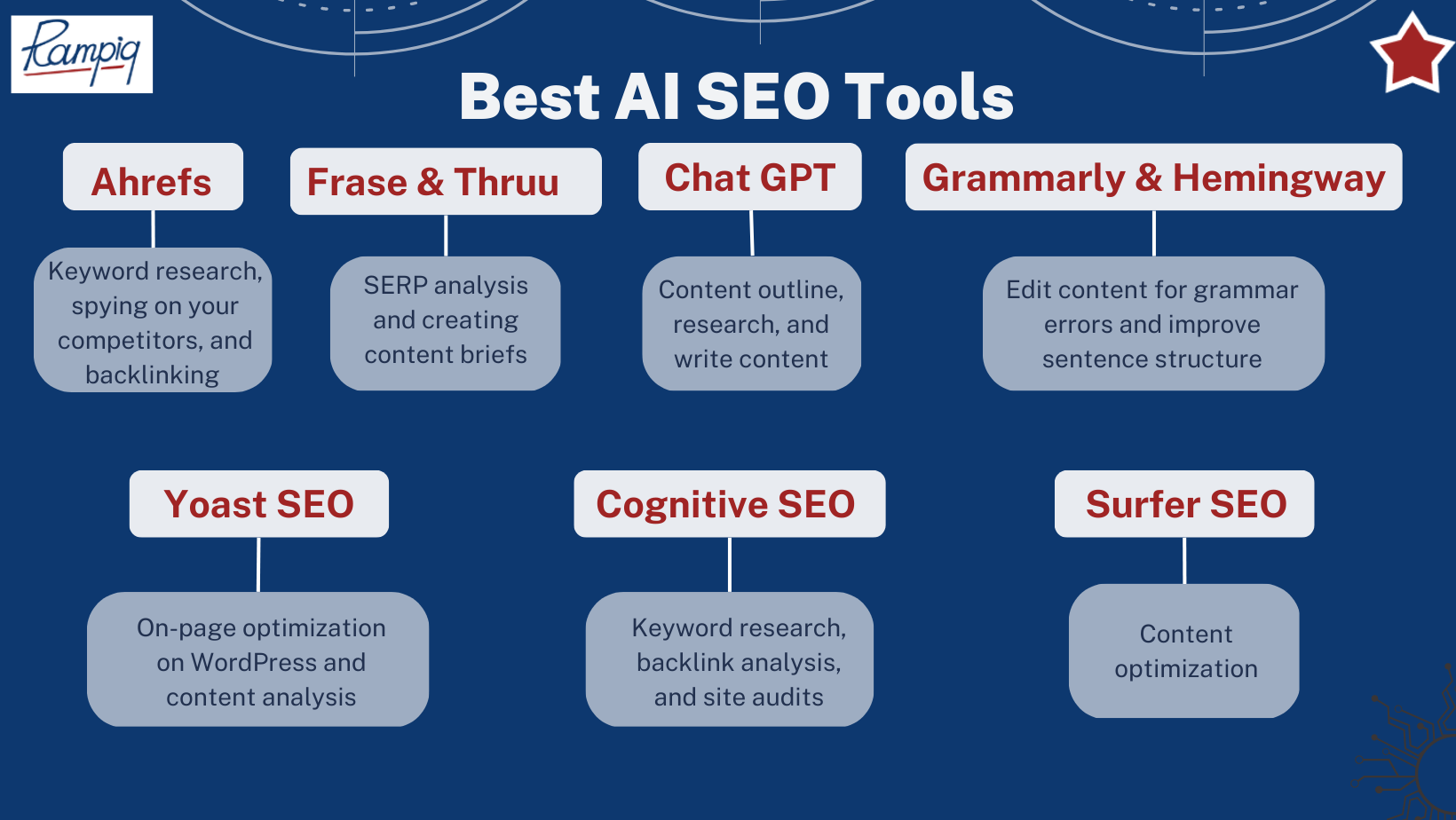
Artificial intelligence can make your work easier and better. Here are some of the tools that we recommend for specific tasks.
- Ahrefs: Keyword research, spying on your competitors, and backlinking.
- Frase & Thruu: SERP analysis and creating content briefs.
- Chat GPT: Content outline, research, and write content.
- Grammarly & Hemingway: Edit content for grammar errors and improve sentence structure.
- Yoast SEO: On-page optimization on WordPress and content analysis
- Cognitive SEO: Keyword research, backlink analysis, and site audits.
- Surfer SEO: Content optimization.
The Challenges and Limitations of AI for SaaS SEO
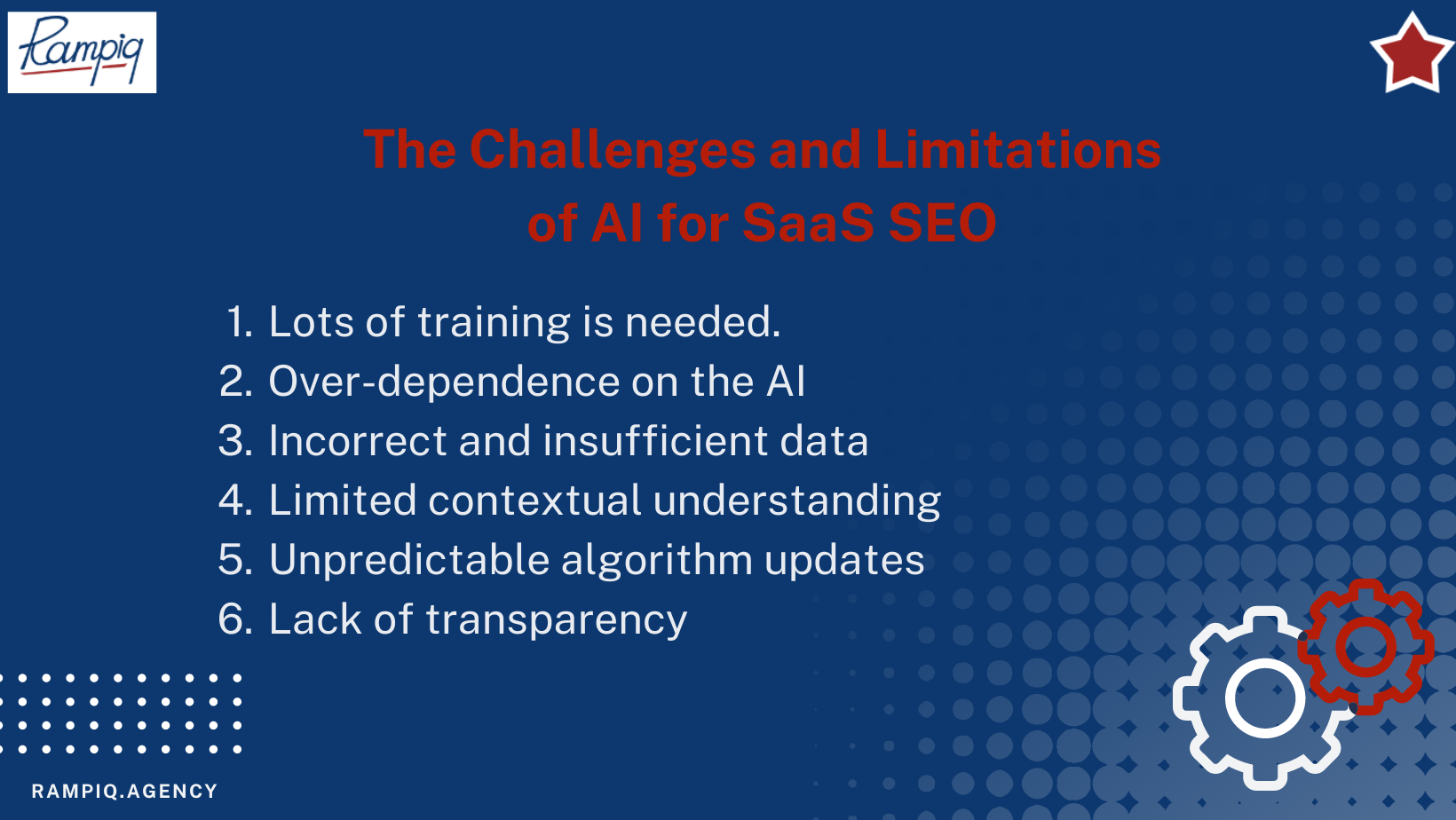
As much as they’re many benefits that come with AI for SaaS SEO, some challenges come with integrating AI into your marketing. They include:
1. Lots of Training is Needed.
To begin with, you need to train your team on how to use AI the correct way. But that’s all a different problem – you must train your AI to align with your marketing goals, understand your trends, build expertise, and understand your customer’s behavior. This takes time to fully get up to the level suitable for working on tasks without having a specialist review the work.
2. Over-Dependence on AI
While AI is helpful too in SaaS SEO, that’s all it should be, a tool. SEO is still a complex subject requiring a human touch to get quality organic traffic and rank better. Unfortunately, introducing your team to AI risks them over-relying on it and missing crucial details that could tank your strategy.
3. Incorrect and Insufficient Data
Despite how impressive AI tools are, AI technology is still in the early stages and needs tons of data before it can be reliable and effective. That’s why tools like ChatGPT have been on the freemium model in an effort to learn more information. At the moment, the model can only provide information up to 2021. This means there is a limit to information when using AI. For example, if you ask ChatGPT to generate keywords for a page, it can’t get keywords that fit the right criteria, as that needs real-time search data.
3. Limited Contextual Understanding
Most AI writing tools, for example, are still learning the tone to use in different texts, while this may seem like a minor glitch, a wrong tone can make your customers feel misunderstood or offended. This and similar instances pose considerable challenges in SaaS SEO, where language is a significant factor in how someone can perceive context.
4. Unpredictable Algorithm Updates
The primary goal of SaaS SEO is getting long-term organic SEO; when done right. It only gets better as time passes by. However, some AI tools like ChatGPT have only been heavily used for the past six months in content marketing, and we have yet to learn how the Google Algorithm will rank AI content.
Also, algorithms are constantly changing to meet the user’s needs, and it might take a lot of work for AI platforms to keep up.
5. Lack of Transparency
AI models don’t offer much information on how they get the results they do, so they can be misleading. Due to a lack of transparency, you must take everything you generate from them with a pinch of salt, which means lots of verification. Sometimes, double-checking the sources can take longer than doing everything manually.
Predictions for the Future of AI and SaaS SEO
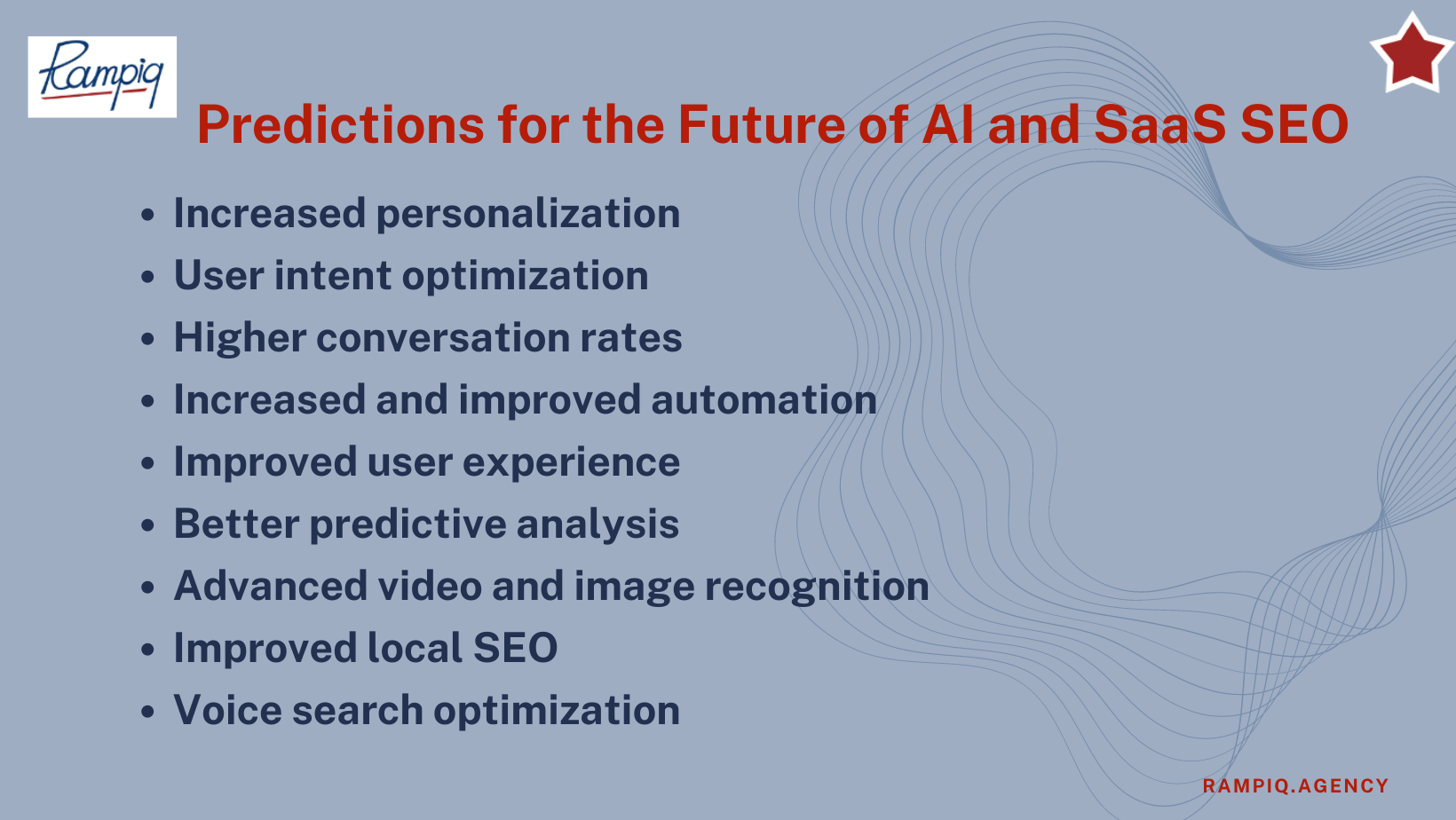
It’s hard to know what the future of AI and SaaS SEO will look like; here are a few predictions on how they will evolve together:
- Increased personalization: AI will become more “human-like” and learn to generate accurate, personalized data.
- User intent optimization: NLP will become crucial as Google, Bing, and other search engines will better understand the user’s intent.
- Higher conversation rates: More companies will employ AI-powered chatbots in their customer care departments and sales; this will mean better and more efficient customer service. The chatbots will improve website user interface and personalization to give customers the content they need when they visit an online store. This will result in satisfied customers and higher conversion rates.
- Increased and improved automation: More automation in marketing. Marketers will automate activities like link building, keyword research, and analytics.
- Improved user experience: As SaaS companies use AI-powered bots, they’ll understand human behavior more, leading to a better customer experience.
- Better predictive analysis. AI’s will better analyze past data to predict more accurately; this will be a considerable breakthrough for SaaS SEO as they’ll know what their customers need before asking for it.
- Advanced video and image recognition: This will help Google understand searcher’s intent better and rank content that includes helpful visuals better.
- Improved local SEO: Businesses will understand what their target customers want by location as they use AI tools to monitor their behavior and buying journey.
- Voice search optimization: As businesses use AI tools to optimize their sites, searchers will use voice assistants more.
The Ethical Implications of AI in SaaS SEO
As more and more SEO professionals utilize the ever-growing number of AI models and tools for help in accomplishing SEO tasks, it’s important to consider the ethical implications.
Here, we’ll explore some of these concerns and see how to mitigate the risks.
1. The Risk of Bias
AI algorithms learn from historical data and therefore inherit biases that are present in this data. What this means is that the AI system may show bias in some way if the data used to train it is biased.
An example perhaps is an AI system that is trained using data that skews a search term towards a demographic. This may in turn make the system less effective in targeting other groups and cause unfairness in search rankings. This can even impact businesses or people.
A way to mitigate this risk is to always ensure to consider the data with which you train your AI system. Alternatively, only use standard third-party tools that show no noticeable biases.
You may also want to monitor the systems regularly to make sure that their results don’t exhibit unfair biases.
2. The Threat of Automation
More advanced AI systems pop up every day, and at this rate, there’s a real possibility that these systems could eventually replace human workers in certain SEO tasks.
When this happens, businesses will generally see increased efficiency and they’ll save costs. However, it could severely impact the job market. This applies to many other industries, too.
To address this scary threat, its professionals should acquire the technical skills to work alongside AI systems, using them as tools. On the part of the businesses, they can support their workers by retraining them in new roles that cannot be automated.
3. The Responsibility of Transparency
As a business, your consumers or subscribers have a right to know how you use their data. Despite you having to be transparent to comply with this ethical standard, the customer’s right, being transparent about your handling of their data also builds trust.
You can use AI systems for SEO and avoid this risk by communicating clearly your data collection and usage practices. For example, if you are going to generate dynamic meta tags using AI, you should mention this and state how.
Lastly, as pertains to data collection transparency, it is always necessary to provide your consumers with an easy option to opt out of data collection.
With AI for SEO, as with any other technology, you must ensure that you use it ethically and responsibly. When you do these seemingly simple things, they will translate into more trust with your customers and makes the online ecosystem more equitable.
Using AI for SEO: Frequently Asked Questions
Here are some common questions asked in regard to using AI for SEO:
Can Google Identify AI-written content?
Yes, Google can now identify AI-written content. However, Google currently doesn’t have an issue with AI-generated content as long as it’s well-edited to be helpful to the readers.
Is AI Content Good for SEO?
AI content can be good for SEO when well edited to meet the customer needs and adequately answer the question. Ensure you also double-check the content to ensure everything is accurate. If your content is relevant to your question, it will help your SEO efforts.
Can SEO be Automated?
Yes, several parts of SEO can be automated using the correct tools. These include link building, site auditing, and keyword research. However, you still need a professional to double-check the processes.





